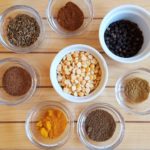People commonly fret about protein in a plant-based diet, but they should be asking about fiber. 97% of Americans do not get the recommended daily amount of fiber.
That bears rephrasing: nearly every American’s diet is deficient in fiber.
What is fiber? Fiber is roughage that is too complex for the body to break down. It can’t be digested, which is what makes it so valuable. It’s found only in plant foods.
Dietary fiber is classified as either soluble or insoluble.
Soluble fiber turns gelatinous in your colon. It slows digestion and can help decrease cholesterol. It is found in foods like oat bran, barley, nuts, seeds, beans, lentils, peas, and some fruits and vegetables.
Insoluble fiber is non-digestible and passes through your colon virtually unchanged. It speeds up digestion and “bulks” up your stools but does not impact cholesterol. Insoluble fiber is found in foods such as whole wheat flour, wheat bran, green beans, and potatoes.
Try not to get wrapped up in what kind of fiber you eat. Eating a diet of fruits, vegetables, legumes, and whole grains will provide a healthy mix.
Why is fiber important? Fiber will help reduce your risk of high cholesterol, obesity, type 2 diabetes, heart disease, and certain digestive disorders. Scientific studies comparing populations that eat a lot of fiber with groups that eat little (i.e., most Americans) have found reduced rates of colon cancer in the first group, but it’s not conclusive whether that result is due to fiber in the first group, or the animal fat and meat in the second.
But the bottom line: fiber is good for you, regardless of whether or not it decreases your risk of colon cancer.
How much fiber do I need? The minimum daily requirement varies with gender and age: 38 grams for men under 50, 30 grams if over 50; 25 grams for women under 50, 21 grams if over 50. Don’t worry too much about the numbers though. Eat sufficient calories and a variety of plants and you’ll be fine. Your colon likes the real deal from nature, not tablets or fortified cereals. Fruits and vegetables are rich in antioxidants, micro-nutrients, and phytochemicals – all of which are proven to promote health.
A suggestion. Add more fiber to your diet gradually. Your body needs to get used to it. The bacteria in your stomach and small intestine need time to catch up. Adding too much fiber too quickly can cause gas and bloating. Drink plenty of water.
Where can I find fiber? There is no fiber in animal products. Only plants have fiber. Some great examples are nuts and seeds, cooked beans, fruits – especially citrus, berries, prunes, figs, and apricots. Shredded zucchini, cabbage, and carrots can be added to salads, soups, and stir-fries. Avoid white flour and white rice; instead, use whole grain rice, pasta, and bread. Snack on popcorn. Serve a baked apple for dessert instead of cake or cookies. Add ground flaxseed to cereal, breads, muffins, wraps, casseroles—almost everything.
This month’s recipe features lentils, my favorite legume. They can be made into so many delicious stews, soups, sauces, and loaves. I’ve made this flavorful curry recipe many times, and it always gets rave reviews.
Makes six servings, with almost 17 grams of fiber in each. Serve it over brown rice (more fiber!). Or, add more liquid, for example 2-3 cups of vegetable broth, and serve it as a flavorful soup.
Creamy Lentil Curry
Ingredients
- 2 tablespoons coconut oil I use the fat from the top of the can of coconut milk, also an ingredient
- 1 teaspoon cumin
- 1 teaspoon coriander
- 6 cloves of garlic
- 1 28- ounce can of crushed tomatoes
- 2 tablespoons ginger chopped
- 1 tablespoon turmeric
- 2 teaspoons sea salt
- 1 cup dried brown lentils
- 1/4 teaspoon cayenne powder
- 3 cups water
- 1 15- ounce can light coconut milk
- 1 cup cherry tomatoes sliced in half
Instructions
- Heat the coconut oil in a large pot or skillet over medium heat. Add the cumin, coriander, and garlic to the pot and let it soften, about 2 minutes.
- Add the can of crushed tomatoes, ginger, turmeric, and sea salt to the pot and cook, stirring the pot a few times, for 5 minutes. Add the lentils, cayenne, and 3 cups of water to the pot and bring it to a boil. Reduce the heat to low, cover the pot, and let it simmer for 35-40 minutes, or until the lentils are soft. Stir the pot a few times to prevent the lentils from sticking to the bottom. If the curry starts to look dry, add an extra 1/2 – 1 cup of water.
- Once the lentils are soft, stir in the coconut milk and cherry tomatoes and bring the pot back to a simmer for a couple of minutes.
First published in Chatham County Line, , Vol 18, Issue 1

